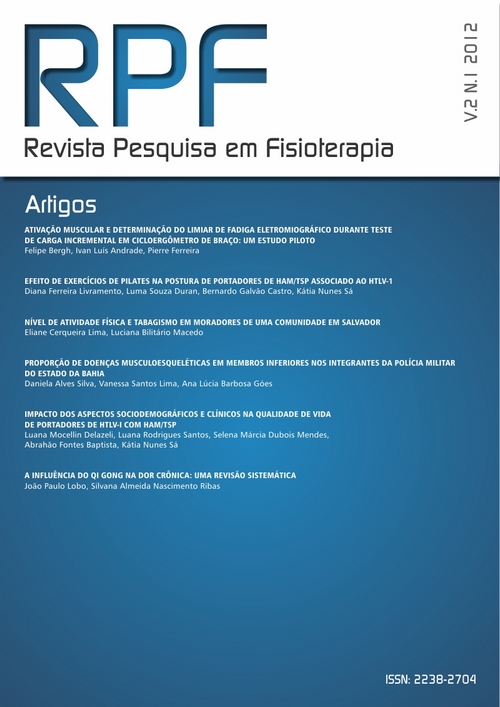IMPACT OF SOCIO-DEMOGRAPHIC AND CLINICAL ASPECTS IN QUALITY OF LIFE OF PATIENTS WITH HTLV-I HAM / TSP
DOI:
https://doi.org/10.17267/2238-2704rpf.v2i1.85Keywords:
Lymphotropic virus, HAM-TSP, HTLV-1Abstract
Introduction: The T-cell lymphotropic virus Humanities - HTLV-1, human retrovirus, can cause, among others, a neurological disorder, tropical spastic paraparesis / myelopathy associated with HTLV-1 (HAM / TSP). It is a progressive and debilitating and may cause gait disturbances, muscle weakness and stiffness of the lower limbs, and impaired balance, which impacts the quality of life of people infected. Objective: To investigate the association domains of quality of life with sociodemographic and clinical aspects in patients with HTLV-I HAM / TSP. Methods: Observational study of cross-sectional sample of 115 patients with HTLV-1 with HAM / TSP in a reference center. These data were verified using the SF-36 and form a demographic and clinical data. We used the chi-square test to test the level of significance between the variables: age categorized, skin color, social class, marital status, education and diagnosis of HAM / TSP categorized, which were related to the areas of Quality of Life of the SF-36. The Student's t test was used in research to test the relationship between the variables: sex, physical activity and physical therapy associated with the domains of quality of life. Results: It was found that 69.6% of participants were female, 72.2% were aged 35-64 years, 59.1% belonged to social class D and 29.6% had low education. When comparing the domains of quality of life with the diagnosis of HAM / TSP, there was greater impairment in functional capacity (p = 0.001) and physical appearance (p = 0.002). Belonging to the female gender and low social class have generated greater loss of quality of life. Conclusion: The most affected areas of QoL in patients with HTLV-1 with HAM / TSP were defined functional capacity and physical appearance. The people most affected were adult females belonging to the class D.Downloads
Download data is not yet available.
Downloads
Published
12/22/2012
Issue
Section
Original Articles
How to Cite
1.
Delazeli LM, Santos LR, Mendes SMD, Baptista AF, Sá KN. IMPACT OF SOCIO-DEMOGRAPHIC AND CLINICAL ASPECTS IN QUALITY OF LIFE OF PATIENTS WITH HTLV-I HAM / TSP. Rev Pesq Fisio [Internet]. 2012 Dec. 22 [cited 2024 Nov. 23];2(1). Available from: https://www5.bahiana.edu.br/index.php/fisioterapia/article/view/85



